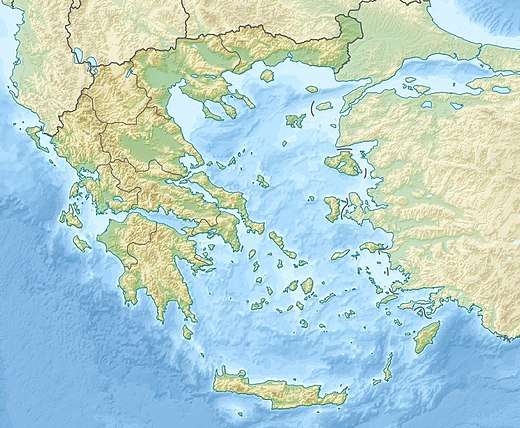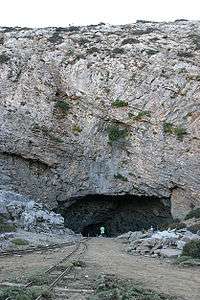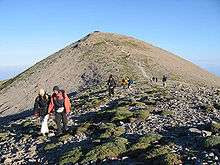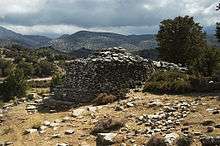Mount Ida (Crete)
Mount Ida (Greek: Ἴδα),[3][4] known variously as Idha, Ídhi, Idi, Ita. The massif including the mountain is called Psiloritis (Greek: Ψηλορείτης).[5]
| Mount Ida | |
|---|---|
| Psiloritis (summit Ida) | |
.jpg) View of Psiloritis mountains from west | |
| Highest point | |
| Elevation | 2,456 m (8,058 ft) [1] |
| Prominence | 2,456 m (8,058 ft) [2] |
| Listing | Ultra |
| Coordinates | 35°13′36″N 24°46′21″E [2] |
| Geography | |
 Mount Ida Location in Greece | |
| Location | Crete, Greece |
At 2,456 m (8,057 feet), Ida is the highest mountain on Crete. It has the highest topographic prominence in Greece.[2][6] A natural park which includes Mt. Ida is a member of UNESCO's Global Geoparks Network.
Located in the Rethymno regional unit, Ida was sacred to the Greek Titaness Rhea. On its slopes lies one of the caves, Idaion Antron, the Idaean Cave, in which, according to legend, Zeus was born. Other legends, however, place his birthplace in Psychro Cave on the Lasithi Plateau.
Features
The Psiloritis is located on the water divide between the southern part of Crete, tributary of the Libyan Sea, and the northern one, facing the Aegean sea. A saddle at 2,321 m East of the summit connects it with Mount Agathias[1], while westwards the ridge contiunes with Mount Stolistra (2,336 m)[7]
The Skinakas observatory of the University of Crete is located on the secondary peak Skinakas at 1750 m. It has two telescopes including a 1.3 m Modified Ritchey-Chrétien instrument.[8][9]
The Nida plateau is found to the east of the mountain.[10] On the plateau are some shepherd's huts (mitata) built only of local stones, and used both for shelter and for cheesemaking.[11][12][13]
Mythology
Mount Ida is the locus for a race of legendary ancient metal workers Dactyls.
«ferrum Hesiodus in Creta eos qui vocati sunt Dactyli Idaei.» (Hesiod attributes the invention of metallurgy in Crete to those who were called Idaean Dactyls.)
— Pliny the Elder, Historia naturalis, VII.197
Idaean Cave
In ancient times the Idaean cave, "cave of the Goddess" (Dea) was venerated by Minoans and Hellenes alike. By Greek times the cave was rededicated to Zeus.[14] The cave where Zeus was nurtured is variously stated to be this cave, or another of the same name, or the Dictaean cave.[15]
Votive seals and ivories have been found in the cave.[16] Like the Dictaean cave, the Idaean cave was known as a place of initiations.[17] It may have served as the site of an oracle, symbolized by the frequent depiction of a tripod on coins of nearby Axos, which presumably controlled the territory around the cave.[18]
Gallery
 Mouth of the Idaean Cave
Mouth of the Idaean Cave East ridge of summit Ida.
East ridge of summit Ida. Shepherd's hut (mitato) on Nida Plateau, eastern side of Mt Ida
Shepherd's hut (mitato) on Nida Plateau, eastern side of Mt Ida
See also
- 243 Ida, an asteroid named after the mountain
- Mount Ida, known as the Phrygian Ida in classical antiquity
- Idaea
- Mount Kedros
External links
References
- "Mount Ida, Greece". Peakbagger.com. Retrieved 2 May 2015.
- "Europe Ultra-Prominences". Peakbagger.org. Retrieved 2 May 2015.
- Verse 332 of the act B, of the bucolic drama Πανώρια by the 16th century Cretan writer Γεωργίος Χορτάτσης: «Ἐγὼ δὲ θὲ νὰ παντρευτῶ καὶ βρὲ ἄλλη κορασίδα, ἀπ’ ὄμορφες ἀρίφνητες ἁπού ‘ν’ ἐπὰ εις τὴν Ἴδα˙» (The tomonym is mentioned several times in this work.)
- Summit Ida in the center of the map, by Marco Boschini, 17th century Venice. Item (GE C-8841) National Library of France.
- Psiloritis in the center of the map, by Abraham Ortelius, 1598 Antwerp, from Archipelagi Insularum Aliquot Descrip.
- Topo25 Hiking Map of Mt IDHA (2006 edition)
- 1:35.000 scale map nr.11.14 - Ψηλορείτης (Agathias) (Map). Anavasi.
- "Skinakas Observatory". University of Crete Department of Physics. Retrieved 15 March 2015.
- "Skinakas Observatory". Skinakas Observatory. Retrieved 15 March 2015.
- "Introducing Mt Psiloritis". Lonely Planet. Retrieved 15 March 2015.
- Antonis Plymakis, Koúmoi-Mitáta kai Boskoi sta Leuká Ori kai Psiloriti ("Shepherd's huts and shepherds in the Lefka Ori and the Psiloritis"), Chania, 2008, 630 p.
- Harriet Blitzer, Pastoral Life in the Mountains of Crete. An Ethnoarchaelogical Perspective, in Expedition, vol. 32, No 3, 1990, pp. 34-41 (on the shepherd's huts of Eastern Crete.
- Sabine Ivanovas, Where Zeus Became a Man (with Cretan Shepherds), Efsthiadis Group Editions, 2000, 183 p. (Life in the corbelled dry stone huts of central Crete).
- Diodorus Siculus, V.70.
- William Smith, ed. (c. 1873). A Dictionary of Greek and Roman biography and mythology. John Murray.
- J. Lesley Fitton,Ivory in Greece and the Eastern Mediterranean from the Bronze Age to the Hellenistic Period (British Museum. Dept. of Greek and Roman Antiquities),1992
- Yulia Ustinova, Caves and the Ancient Greek Mind: descending underground in the search for Ultimate Truth 2009:180.
- Ustinova, noting Capdeville 1990, and, critically, Prent 2005:568.
| Wikimedia Commons has media related to Mount Ida, Crete. |